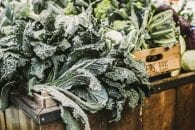Iron deficiency can cause anemia, a shortage of hemoglobin in the blood. This can lead to weakness, fatigue, a pale face and earlobes, and brittle, spoon-shaped nails. There are other causes of anemia besides nutritional deficiencies, including massive or chronic blood loss. The best way to tell if you have enough iron in your body is to find out if you have enough iron in your blood. A “finger-stick hemoglobin” check can be done in your doctor’s office. This test requires only one tiny drop of blood, and the results are available within a few minutes. Pediatricians often use this test to check hemoglobin levels in nine-to fifteen-month-old infants. Your doctor may check hemoglobin levels at other ages of increased iron needs too, such as during female adolescence or pregnancy. Normal hemoglobin values are:
- infants and children 11 to 13 grams
- women 12 to 16 grams
- men 14 to 18 grams
You can prevent iron-deficiency anemia by making wise food choices for yourself and your family. Getting your daily iron from food is preferable to taking iron supplements, which sometimes cause abdominal discomfort and constipation. Here are some ways to assure there is enough iron in your family’s diet.
- Breastfeed your baby as long as possible. Once upon a time it was believed that breastfed babies needed iron supplements because human milk was low in iron. Yet, breastfed babies studied at four to six months of age had a higher hemoglobin than infants who were fed iron-fortified formula. Breastfed babies have been found to have sufficient iron stores for nine months or longer. Human milk remains an important part of baby’s diet, even after the introduction of solids.
- Use an iron-fortified formula. If bottle feeding, use an iron-fortified formula, preferably beginning at birth, but at least starting by three months of age. Continue iron-fortified formula for at least one year or as long as your baby’s doctor recommends, which is usually until your infant is eating adequate amounts of other dietary sources of iron. Do not use “low-iron” formulas, which do not contain sufficient iron for a growing baby’s needs.
- Delay cow’s milk feeding for infants; limit it for toddlers. The Committee on Nutrition of the American Academy of Pediatrics recommends that parents delay using cow’s milk as a beverage until a baby is at least one year of age. There are two iron-related reasons for this: cow’s milk is low in iron, and cow’s milk can irritate the intestinal lining, causing bleeding and the loss of iron. This is a tiny amount of blood loss, but over a long period of time it can be significant. The combination of poor iron intake and increased iron loss sets a baby up for iron deficiency anemia, and excessive milk consumption is a common cause of iron deficiency anemia in toddlers. An eighteen-month-old who consumes forty ounces of milk a day may be plump, but is probably very pale. Unless advised otherwise by your baby’s doctor, limit your toddler’s cow milk intake to no more than 24 ounces a day.
- Combine foods wisely. Eating a food rich in vitamin C along with a good iron source will help your body use the iron. Here are some classic examples:
- spaghetti with meat and tomato sauce
- meat and potatoes
- chicken fajitas with broccoli, sweet pepper, and tomatoes
- hamburger and coleslaw
- nitrate-free hot dogs and orange juice
- fruit, iron-fortified cereal, and raisins
- fresh fruit with raisins
- Try prune juice as a regular beverage. Prune juice is one of the few juices that is high in iron (3 milligrams of iron per cup). The process involved in making prune juice retains more of the fruit’s original nutrients than the juicing of other fruits.
NUTRITIP Don’t Skin the Iron
Leave the skin on the potatoes when making homemade fries. This way you’ll get more nutrition into a french-fry-loving picky eater. The potato skin is rich in nutrients and contains five times the amount of iron as the whole rest of the potato. Compliment those restaurants who have the nutritional wisdom to leave the skins on the fries. And, don’t forget to eat the skin on your baked potato.
- Cook in iron pots. The acid in foods seems to pull some of the iron out of the cast-iron pots. Simmering acidic foods, such as tomato sauce, in an iron pot can increase the iron content of the brew more than ten-fold. Cooking foods containing other acids, such as vinegar, red wine, lemon or lime juice, in an iron pot can also increase the iron content of the final mixture.
- Bake with iron-rich grains. The usual wheat used to make bread and pastries is relatively low in iron (around one milligram of iron per half cup). Lesser known grains, such as amaranth (8 milligrams per half cup) and quinoa (9 milligrams per half cup) are much richer in iron. Barley grains contain four milligrams of iron per half cup. Mixing these grains into the wheat flour you use when you bake will increase the iron content of the finished product.

